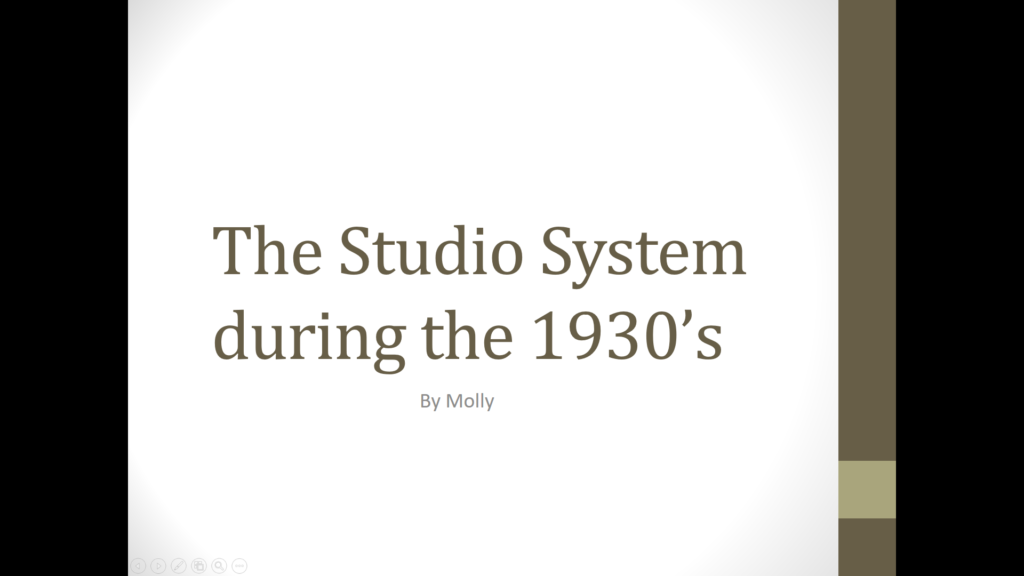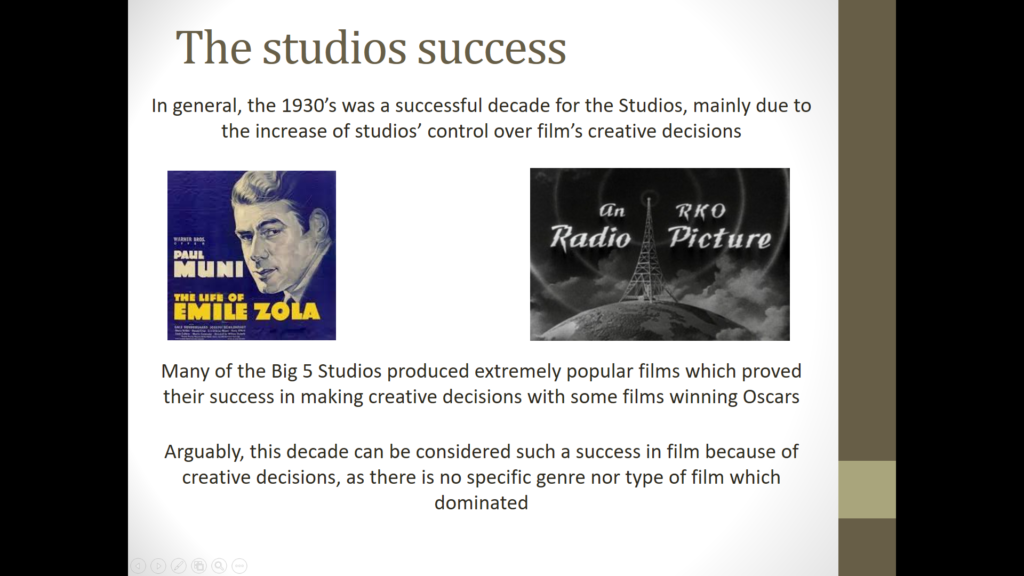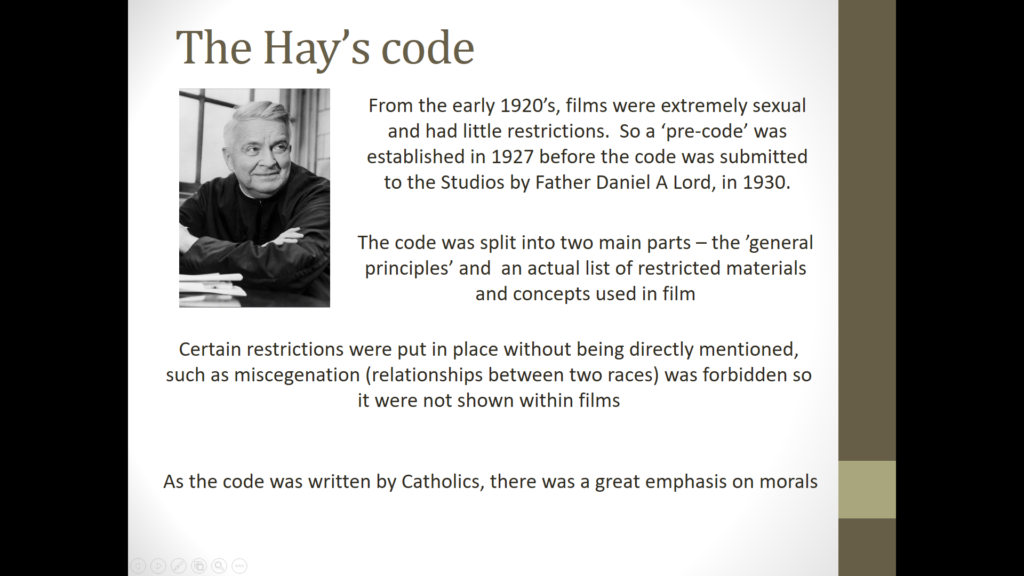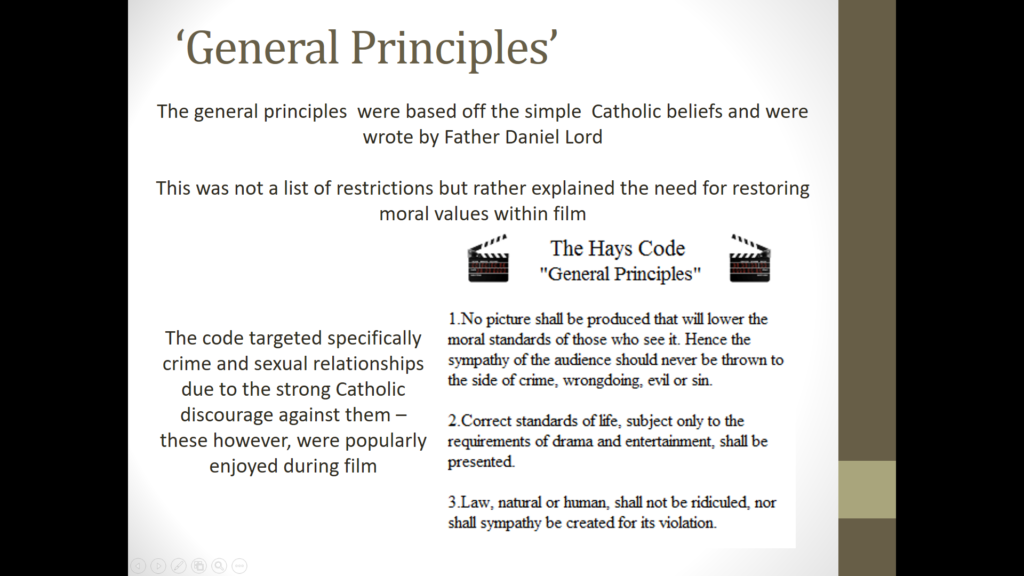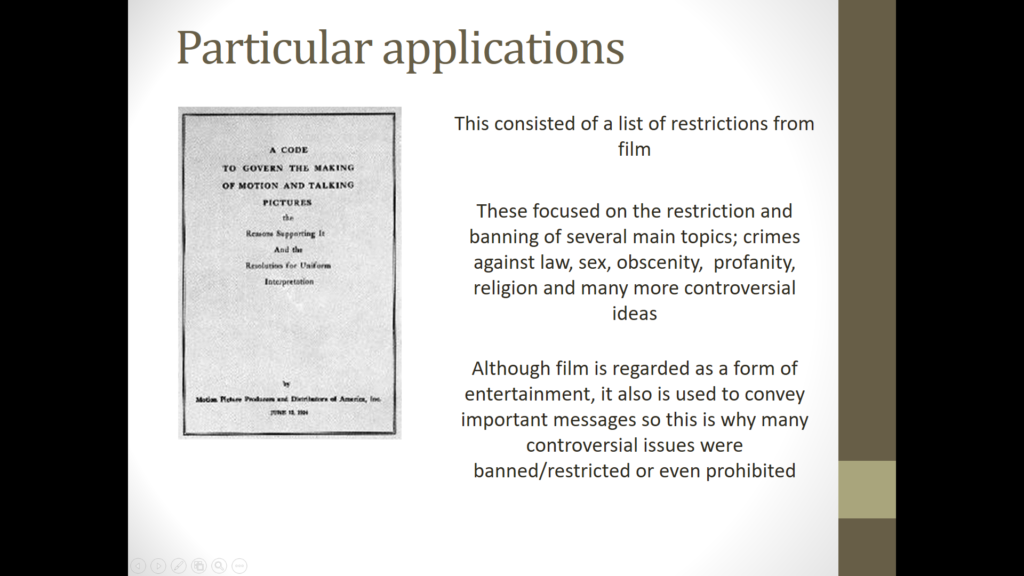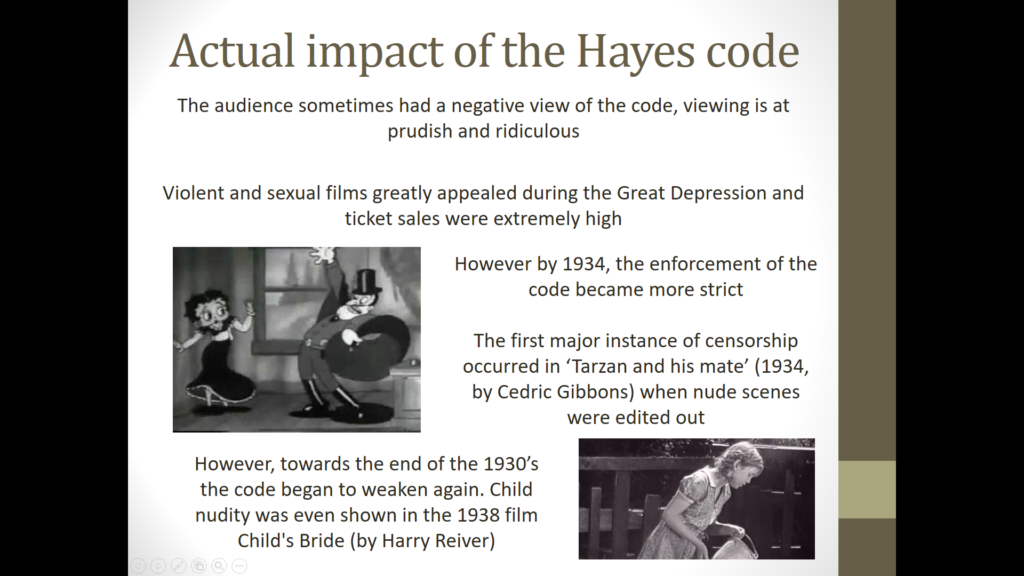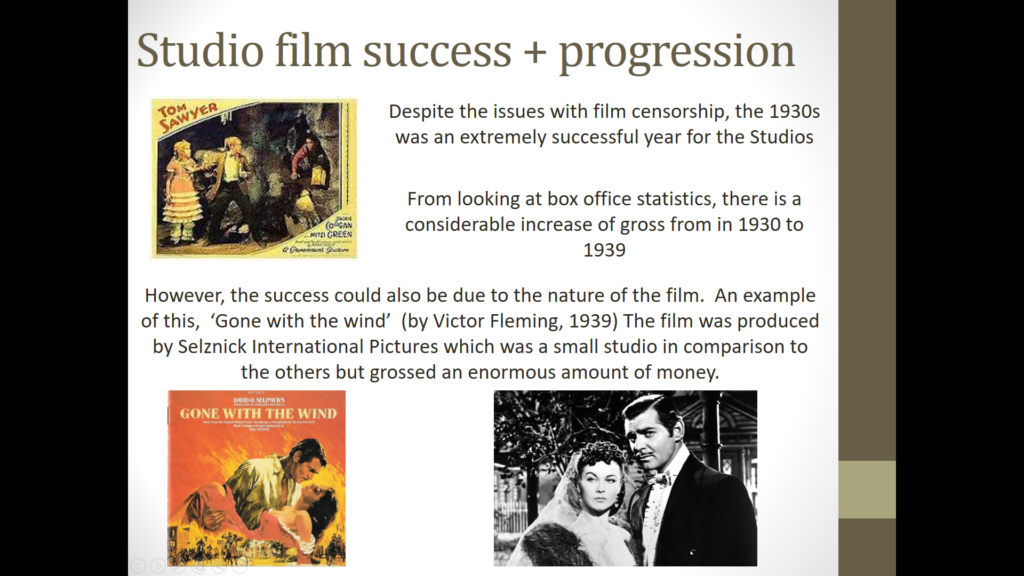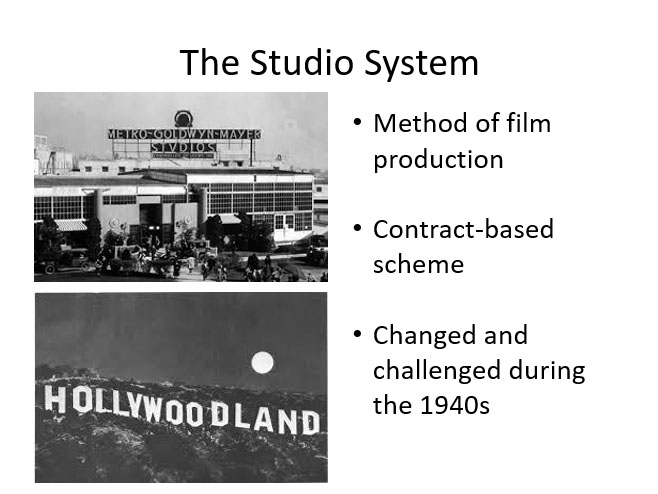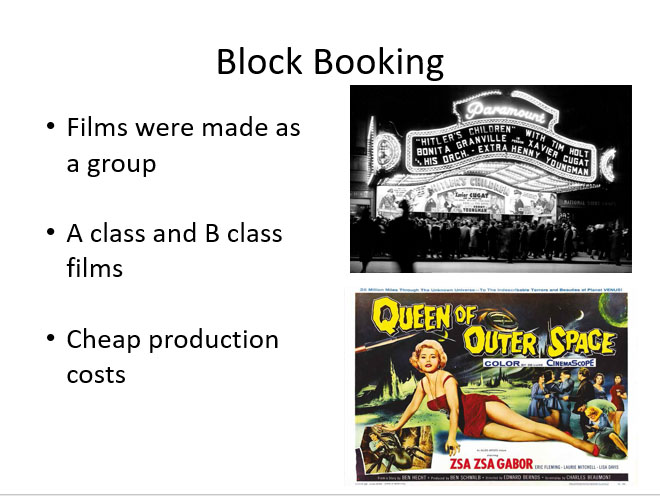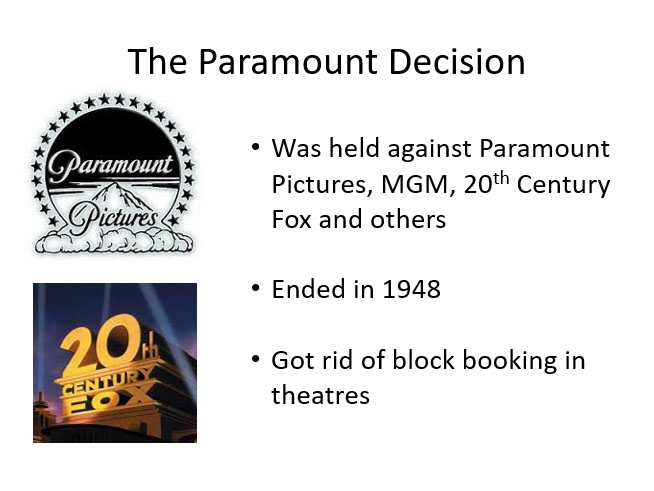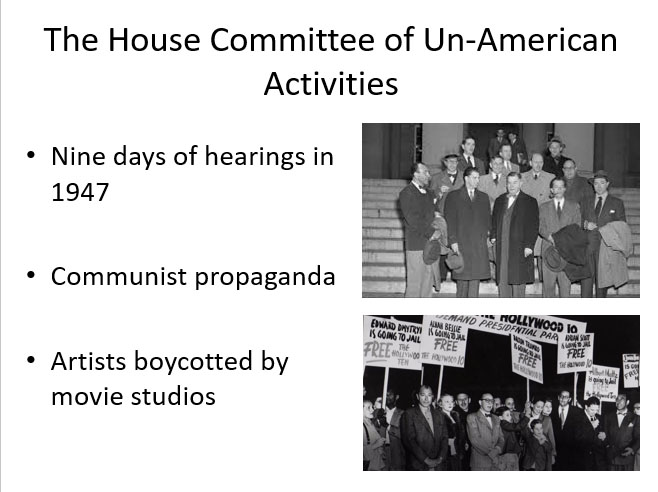Monthly Archives: November 2018
Filters
1930’s Hollywood sound system
1940’s Hollywood
The Studio System
The Studio System was a method of film production used by major Hollywood studios from the 1920s to the end of the 1940s. It was a contract based scheme, so the same people would be employed for movies, rather than finding new people based on talent. During the 1940s, the studio system was changed due to a number of reasons, and a court case was brought up against it, called the Paramount Decision. This, among other reasons, made the studio system come to an end.
Block Booking
Block Booking was a technique that supported the Studio System and helped it to earn millions of dollars. It was when films would be made in a group, usually a bundle of five, and sold to a theatre together so all five would be shown. Film companies owned specific theatres, so only movies shown by that company would be shown there. These movies would typically be one high quality film, an A class film and then a few B class movies. This meant that movie companies could spent little money of producing cheap, B class movies, but still make lots of profit on them as theatres has to show them because of the block booking.
What Ended The Studio System?
There are four main factors that brought around the end of the Studio System. One of these was the Paramount Decision, which reduced the number of films that were being produced. Also, post-war changes in society meant that people didn’t want to see the same sort of films as before, forcing the studios to change. The rise of television meant that less people were going to the cinema or theatres, and the House Committee of Un-American Activities blacklisted many companies and artists in the film industry.
The Paramount Decision
The Paramount Decision was a turning point for movie studios, and it was partly responsible for the end of the old Hollywood Studio System. It was a case in the US Supreme Court that was held against the major movie studios of the time, with Paramount as the main defendant. Other studios involved were MGM, Warner Bros, 20th Century Fox, RKO Pictures, Universal Studios, Columbia Pictures and United Artists. The movie studios were accused of violating the antitrust laws when the distributed their films. When the case ended in 1948, the verdict was against the movie studios, which forced them to get rid of their theatre chains. They were also forbidden to block book movies, or to sell them to theatres without giving the managers a screening first. This was a major factor causing the end of the Studio System.
The House Committee of Un-American Activities
The House Committe of Un-American Activities held nine days of hearings in 1947 about the Hollywood movie industry, claiming that they were producing communist propaganda. Ten individuals were blacklisted after they refused to answer questions in front of the committee. These people became known as ‘The Hollywood Ten’. They went on to blacklist many others, and more than 300 people were boycotted by studios due to their connections with communist propaganda. Only around 10% of these people could rebuild their careers after this, which led to a dramatic decline in the number of moves that were created during this time.
1930s presentation
Film 1930s presentation PowerPoint
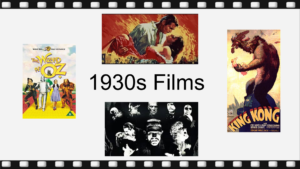
This was the Golden age of Hollywood where American film progressed most.
PowerPoint notes/script
Slide 1

The monster universe was started in the 1920s however its major success occurred in the 30s as it became considered as the first cinematic universe in film history as this decade left the foundations for the next few decades of universal monsters.
The films themselves were successes with over 20 films being made in that 10 year period, 18 what were released and a remake in a second language. Out of all the decades of the universal monster films this has the best and highest reviews with only one movie getting a review less than 70% on rotten tomatoes this shows how these movies have lasted over time accept for the Son of Frankenstein, with 5 films being ranked at a 100%. Frankenstein as well was top of the box office in 1931 making $12 million on a $262,000 budget what has been ranked by the Film institute the 87th best movie of all time. Dracula also gets onto one of the lists as for being the 33rd best villain of all time.
Dracula, Frankenstein and the Invisible Man have all been selected in the US film national registry by the liberty of congress for being culturally, historically and aesthetically significant.
However horror genre was hurt by the Hayes code as it restricted the genre while also hurting the product of already released films as this led to the decrease in films the for the rest of the decade. It also started the decline of the monster universe.
Slide 2
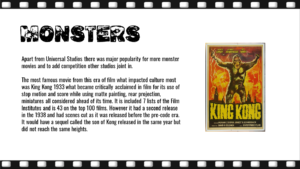
Dr Jekyll and Mr Hyde was another monster film separate to Universal, but this is more well known for the performance than the technological breakthrough. Fredric March’s performance is considered a masterclass with him winning a academy award and was seen on par with Universal Studios horror films. Mirrors Warner Brothers and other studios trying to create a cinematic universe.
Slide 3
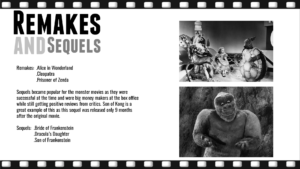
Slide 4
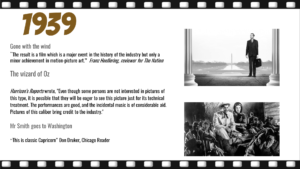
GWTW and TWoO(Flemming)
Gone with the wind and The Wizard of Oz are both considered historically significant in film with both being breakthroughs. Both considered in the top 10 films of all time by the film institute with them being directed both by the same director these are seen as classics. Both movies in together were nominated for 19 awards and winning 15. With inflation Gone with the Wind has become the highest grossing film of all time with $3.7 billion as of 2017. Wizard of Oz is mostly famous for being the first film to be in technicolor. While Gone with the Wind is considered as good by how its casting performance what was seen as incredible from critics while also becoming a breakthrough even with all issues surrounding the production of it.
Mr Smith goes to Washington(Capra)
Was nominated for 11 academy awards and won for best story. Hurt by its controversial opening likely making it less popular than it was actually should of been, it is considered as one of the best films of all time ranking at 29.
Others
Stagecoach(Ford) is ranked as the best Western of all time, The Rains Came(Brown) nominated for 6 academy awards, Gunga Din(Stevens) seen as historically significant.
Slide 5

Victor Fleming: Victor Fleming is one of most decorated and successful directors of all time and is the most celebrated one in the 1930s. During the 1930s he directed 13 movies including movies such as Treasure Island, test pilot and captain courageous however he is most notably famous for his movies of 1939. In 1939 he released 2 movies what are in American Film institute top 10 movies with them being gone with the wind and the wizard of Oz. Both are still iconic in cinema history today with them both winning 13 academy awards for two movies in the same year.
James Whale: James Whale will go down as one of the main reasons for the success of the Universal monster franchise what was the cinematic universe with him directing the Frankenstein films, the invisible man and the old dark house with all 4 films getting critical reception with 100% on rotten tomatoes.
Norman Z Mcleod made 9 films 1930s
Slide 6

Sir Charles Spencer Chaplin KBE (16 April 1889 – 25 December 1977) was an English comic actor, filmmaker, and composer who rose to fame in the era of silent film. Chaplin became a worldwide icon through his screen persona “the Tramp” and is considered one of the most important figures in the history of the film industry. City Lights and Modern Times both were selected for preservation in the National Film Registry by the United States Library of Congress. In the late 1930s his controversial life led to his decline and parallels the decline of the Golden Era of Hollywood at the time where it looked like it was coming to the end.
Film in the 1930’s
Here is the link to my presentation:
https://jerseyedu-my.sharepoint.com/:p:/g/personal/a_matheson09_hautlieu_sch_je/Eerc8vqS96xBmTMF06tSdOEBgsTTXbuotdNxMjwxuihrKA?e=fLfD6I
film in the 1900’s presentation
Dunkirk Sound Analysis
Dunkirk(Dir. Christopher Nolan) is a historical WWII Thriller/Drama movie based around three storylines. Nolan wanted to make Dunkirk seem different to other war films, and to do this, he decided to focus on sound and specifically the realism and verisimilitude to try and make the audience hear all of the things that a soldier would hear.
The Filmmakers did not want to use any Generic boat and plane sounds, and therefore, many of the sounds heard have been recorded specifically for Dunkirk so that it would sound unique, while also being as realistic as possible. For instance, Richard King, (Dunkirk’s sound editor) placed around 25 microphones around several spitfires, with some behind the pilot, in the engine bay and in the fuselage of the plane so he would have an extremely wide variety of realistic sounds to use. King wanted to convey the “physical sensation” of being in the plane by using a lot of the rattles and shakes caused by the panels of the plane.
For the sequence where there are two soldiers carrying a stretcher, King estimates that they used around 30-40 different tracks, then when editing the scene when the ship is torpedoed, he said the number of tracks used was into the hundreds. King also stated that he didn’t want Dunkirk to remind the audience of other movies and this was the main reason he wanted to “rethink every sound”. A good example of this is when the bombs are being dropped on the beaches. Where most films would bring the pitch of the bombs lower the closer they got to the ground, king decided to do the opposite, saying “when you think about it, the noise should increase in pitch as it gets closer. We reversed all incoming shell sounds so they rose in pitch”. The Sound Mixer, Gary Rizzo, said that Nolan wanted to create “an altered sense of perception” and as many of the soldiers were so young that this would be the first time that they had heard things like a bomb falling in the sand or bullets whizzing past which would have most likley sounded different to how they would have imagined. Nolan creates this feeling for the audience as well, by using different sounds to the kind that the audience would be used to. Almost all of the sounds in Dunkirk had to be re-recorded due to the harsh conditions of wind and rain, not to mention noisy IMAX cameras. Nolan and King put a lot of thought into every sound used throughout the film, even the smallest subliminal ones. Ironically, all of the work that they have put in is intended to make the effort unnoticed to the audience.
Nolan and the film’s composer Hans Zimmer used a technique called a Shepard Tone. This effect is named after the American scientist Roger Shepard, and gives the impression that there is an endless buildup by stacking different pitches of sound waves on top of each other. one high pitched sound getting quieter, one medium pitched sound staying at the same volume, and one low pitched sound getting louder and vice versa. This creates the sense of rising tension as effect will seem to continuously get louder, similar to that of a barber shop pole which will seem to rise forever, but is really just a trick on your eyes; The Shepard Tone is the same trick, but for your ears. This was combined with the ticking sound of Nolan’s personal watch to create a sense of urgency and panic to keep the audience on edge. This sound effect, on top of the original and unique sounds produced for the film, makes the audience feel immersed in the film, creating verisimilitude as well as tension for the audience.
Editing in “Whiplash”
Whiplash is a 2014 American drama film written and directed by Damien Chazelle. It depicts the relationship between an ambitious jazz student (Miles Teller) and an abusive instructor (J. K. Simmons).
The last scene in which Neiman is performing with his drums utilises many different editing techniques to create an effective scene. These techniques include “The Kuleshov effect”. The kuleshov effect is when the camera cuts between two people to show their reactions, and it’s effect causes the audience to see more meaning within the reactions than in a single isolated shot. This effect is used when Neiman is looking at the audience after Fletcher humiliates him, the shot then cuts to the audience, and then back to Neiman’s face. A wide angle is used in the shot of the audience to show just how many people witnessed him failing. This makes the viewers realise how important this performance was for him.
After that, the scene cuts from Fletcher’s reaction to Neiman getting off the stage. There is a contrast within their facial expressions because they contradict each other. Neiman is upset and Fletcher is amused. This emphasises the manipulative-ness of Fletcher’s character, in which it creates sympathy from the audience as the intentions of Fletcher have been exposed and his true colours are revealed. This could also be viewed as a “matched cut” due to both character’s faces being similarly presented other than their expressions. This gives a sense of continuity in the scene, but also amplifies how different their facial expressions are to the audience.
Another editing device used in the next scene is known as a “jump cut”, which is an abrupt transition from one scene to another. This happens during Fletcher’s speech in which the camera speedily cuts three times towards Neiman’s face as he starts playing the drums; interrupting Fletcher. This shows a sense of determination to show the audience what he’s capable of, and it also gives him power over Fletcher as it distracts the audience’s attention. The increase of pace it creates for the scene shows how much impact it has and the risks that are involved in doing this. The scene cuts to show Fletcher’s reaction, which is shocked, which could have the audience fear for Neiman.
During this performance, the camera cuts to show different characters joining in on the song, which are in time with the beat of the music. After this montage of shots, the camera switches to a high angle shot to show the viewers the entire performance. This is used to show the development of the performance and the impact Neiman has created. He went from risking abuse from Fletcher by playing the drums alone, to inspiring other players to join in, and then eventually it turns into a grand performance. Towards the end of the scene, the high angled shot is used once more just to show what Neiman has achieved by doing that.
During the performance, the camera cuts to show Neiman’s dad watching him play. This allows the audience to watch from a different perspective when it cuts back to the stage, while also reminding them that Neiman’s dad is finally seeing what he is capable of. You can see that Neiman cares a lot about his drumming and how passionate he is due to the camera also cutting to different parts of the drum sets, allowing the viewers to realise how talented he is for being able to hit so many parts at the same time, and how much effort he must put in. It also shows blood on one of the symbols, and then cuts to his face to show slight pain as he works. Again, this shows how much he cares about his passion and that he risks pain and effort in order to play. This creates sympathy from the audience and also makes his drumming seem even more magnificent.
The ending to the film shows a resolve I conflict between Neiman and Fletcher. This is a happy ending because it finally rids of the abusive relationship between the two throughout the whole movie. This is presented by another use of the Kuleshov Effect, just like in the beginning. At the end of the scene, a moment where Fletcher and Neiman stare at each other is shown. The camera cuts between their faces a number of times, except their expressions change in the second shots to show them smiling at each other, instead of their expression remaining the same. This smile represents Neiman finally achieving his goal of making Fletcher happy and proud of him for his drumming skills.
Sound in “Dunkirk”
Dunkirk is a 2017 war film written, directed, and produced by Christopher Nolan that depicts the Dunkirk evacuation of World War II.
At the beginning of the film, it is silent for a few seconds until finally it is obstructed by the sound of guns being fired. This creates a sense of tension from the audience as they are forced to wait for something to happen during the silence up until it happens – the sound of a ticking clock can also be heard which shows to the audience that there is only a short amount of time the army soldiers have to get everyone off the beach. It is important for Nolan to get the sounds correct as the film is representing an important time in history, therefore using sound to create a specific atmosphere has to be done delicately in order to portray historical accuracy and also, to create a sense of nervousness from the audience so they can experience the right emotions from it. Also, the film tends to use variation diegetic sounds, which are used in addition to the soundtrack, which allows the audience to feel involved into the film’s world.
A device used in the films known as “Shepard Tone” creates an essence of rising tension within the movie. This is used by scales being an octave a part increase from low to high pitch in a continuous loop. The lower pitch increasing in volume and the higher pitch decreasing in volume creates an illusion where when it repeats, the audience only pays attention to the increasing in pitch rather than it constantly lowering as well. This is used throughout the whole film to create tension and to have it appear to be constantly rising in order to allow the audience to know when danger is coming. This device is normally used during the scenes where the British soldiers are about to be attacked. Another use of sound effects in this movie was a constant heartbeat. This allows a personal relation to the audience. This sound is used because in real life, hearing your own heart beat means that you are usually scared or intimidated by something, which means that danger is near. Being able to hear the heartbeat throughout the film makes the audience know how the characters are feeling, while simultaneously being reminded that they’re still alive.
Sound in Dunkirk
Dunkirk (dir. Christopher Nolan, 2017) is a historical drama/thriller about the British evacuation from Dunkirk during World War Two. The film follows three story lines of three different perspectives of the evacuation – one lasting a week, one a day and one an hour.
https://www.youtube.com/watch?v=1Ml0r-5U3lw
This is the final dog fight scene from the film, where the three different story lines come together during the actual evacuation from the beach. This scene begins by focusing on Farrier in his plane, flying over the beach. The dominant sound at this point is the diegetic sound of the Spitfire’s engines and the propellers spinning. Nolan wanted the sounds of the Spitfires to be authentic, to add to the verisimilitude of the film. During post production, real Spitfire engine noises were added to make the film as historically accurate as possible.
As the sound of the engine dies out, the noises of the propeller and the wind become louder. This signals the moment when Farrier finally runs out of fuel. These diegetic sounds are emphasised as it helps the audience to imagine the situation inside the cockpit, and how the pilot is feeling as he begins to lose control of the plane. Again, this adds to the believability of the film, as these sounds are realistic and it is easy for the audience to imagine that it they really happened.
Beneath all of these sounds, there is a Shepard’s Tone playing. This non-diegetic sound is created by having three octaves that increase in pitch at different speeds. It creates a sense that the music’s pitch is always increasing. During this scene, it adds tension to the action, as it makes it seem like time is running out for Farrier. The Shepard’s Tone is accompanied by a quiet ticking noise, which is a repeating motif throughout the film. This again adds a sense of desperation for the audience, as it makes them even more aware at how little time is left for him in the plane before he crashes.
This Shepard’s Tone is continued for a while through the scene. At the moment where the civilian ships arrive and Commander Bolton is happily talking to the soldiers and nurses, it can still be heard. This makes the audience uneasy, as it suggests that there is still something important to happen. However, as this is a non-diegetic sound, meaning that it doesn’t exist in the world of the film, the characters seem completely unaware of the danger that they still could be facing. However, this scene also features the Nimrod music piece, which reflects the mood of the characters as it sets a joyful, victorious tone.
Towards the end of the scene, a happier score is introduced, just after the German plane is shot down. This music creates a sense of victory and British pride, as it comes at a moment where it seems like everything is going to be alright for the British soldiers. The music starts at the same time as the diegetic sound of the soldiers on the beach below cheering, again making the audience feel a sense of relief as the German plane was defeated. This non-diegetic music also contrasts the darker scores that were heard before in the scene and in the rest of the film, making it feel as if this scene is the climax of the film with a happy ending.

